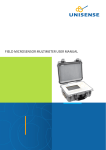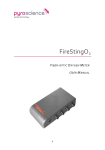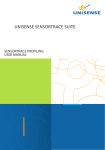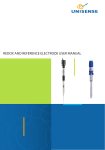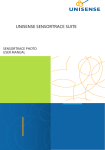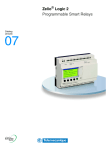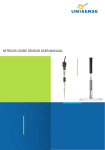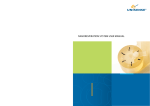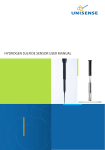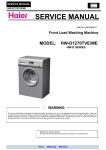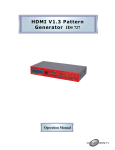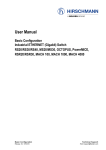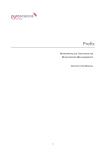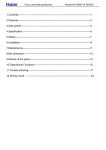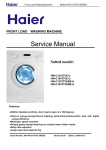Download FIELD MICROPROFILING SYSTEM USER MANUAL
Transcript
FIELD MICROPROFILING SYSTEM USER MANUAL Field MicroProfiling System User Manual Copyright © 2015 · Unisense A/S Version October 2015 FIELD MICROPROFILING SYSTEM USER MANUAL UNISENSE A/S 4 TABLE OF CONTENTS WARRANTY AND LIABILITY . . . . . . . . . . . . . . . . . . . . . . . . . . . . . . . . . . . . . . . . . . . . . . . . . . . . . . . . . . . . 6 Warning6 Warranty and Liability 6 Repair or Adjustment 6 SensorTrace Suite software 6 CONGRATULATIONS WITH YOUR NEW PRODUCT . . . . . . . . . . . . . . . . . . . . . . . . . . . . . . . . . . . . . . 8 Support, ordering, and contact information 8 OVERVIEW . . . . . . . . . . . . . . . . . . . . . . . . . . . . . . . . . . . . . . . . . . . . . . . . . . . . . . . . . . . . . . . . . . . . . . . . . . . . . 9 Properties of the Field MicroProfiling System Software for the Field McroProfiling System 10 11 FIELD MICROSENSOR MULTIMETER . . . . . . . . . . . . . . . . . . . . . . . . . . . . . . . . . . . . . . . . . . . . . . . . . . 12 Internal battery Specification Field Microsensor Multimeter (FMM) 13 14 FIELD MOTOR SYSTEM . . . . . . . . . . . . . . . . . . . . . . . . . . . . . . . . . . . . . . . . . . . . . . . . . . . . . . . . . . . . . . . 15 Field Motor Sensor holder Bracket for stepless positioning of the motor Specification for Field Motor IN SITU AND FIELD STAND . . . . . . . . . . . . . . . . . . . . . . . . . . . . . . . . . . . . . . . . . . . . . . . . . . . . . . . . . . . FIELD MICROSENSORS AND CABLES . . . . . . . . . . . . . . . . . . . . . . . . . . . . . . . . . . . . . . . . . . . . . . . . . EXTERNAL UNITS . . . . . . . . . . . . . . . . . . . . . . . . . . . . . . . . . . . . . . . . . . . . . . . . . . . . . . . . . . . . . . . . . . . . SETTING UP IN THE FIELD . . . . . . . . . . . . . . . . . . . . . . . . . . . . . . . . . . . . . . . . . . . . . . . . . . . . . . . . . . . SETTING UP IN THE LABORATORY . . . . . . . . . . . . . . . . . . . . . . . . . . . . . . . . . . . . . . . . . . . . . . . . . . . ASSEMBLY PROCEDURE 1D MOTORIZED SYSTEM . . . . . . . . . . . . . . . . . . . . . . . . . . . . . . . . . . . . ASSEMBLY PROCEDURE 2D MOTORIZED SYSTEM . . . . . . . . . . . . . . . . . . . . . . . . . . . . . . . . . . . . PROFILING SEQUENCE . . . . . . . . . . . . . . . . . . . . . . . . . . . . . . . . . . . . . . . . . . . . . . . . . . . . . . . . . . . . . . . 1D Motorized profiling 2D Motorized profiling 15 16 17 17 18 20 22 23 25 27 29 31 31 35 STORAGE AND MAINTENANCE . . . . . . . . . . . . . . . . . . . . . . . . . . . . . . . . . . . . . . . . . . . . . . . . . . . . . . 38 TROUBLESHOOTING . . . . . . . . . . . . . . . . . . . . . . . . . . . . . . . . . . . . . . . . . . . . . . . . . . . . . . . . . . . . . . . . 39 5 WARRANTY AND LIABILITY This product is for research use only. Not for use in human diagnostic or therapeutic procedures. Warning Microsensors have very pointed tips and must be handled with care, to avoid personal injury, and only by trained personnel. Unisense A/S recommends users to attend instruction courses to ensure proper use of the products. Warranty and Liability The Field MicroProfiling System is covered by a one year limited warranty. The warranty does not include repair or replacement necessitated by accident, neglect, misuse, unauthorized repair, or modification of the product. In no event will Unisense A/S be liable for any direct, indirect, consequential or incidental damages, including lost profits, or for any claim by any third party, arising out of the use, the results of use, or the inability to use this product. Repair or Adjustment Sensors and electrodes cannot be repaired. Equipment that is not covered by the warranty will, if possible, be repaired by Unisense A/S with appropriate charges paid by the customer. In case of return of equipment please contact us for return authorization. For further information please see the documents General Terms of Sale and Delivery of Unisense A/S, and Warranty and Shipping Information as well as the manuals for the respective products. SensorTrace Suite software Unisense SensorTrace Suite software is checked and validated for the Windows platform as given in the specification. Customer must ensure PC is fully updated and no conflicting third party software is installed. Unisense do not warrant compliance with any other operating systems, language settings or third party software. 6 For instrumentation and sensors, please refer to our warranty conditions as given in the document “General Terms of Sale and Delivery of Unisense A/S” found on www.unisense.com License agreement The following terms shall apply to the software provided by Unisense A/S (“Unisense”) in connection with the simultaneous sale to you (“Customer”) of a Unisense SensorTrace Suite Software. All rights, title and interest in the software belong to Unisense. Unisense grants to the Customer a royalty-free, non-exclusive and non-transferable license to use the software solely in connection with the Unisense Product purchased from Unisense simultaneously with the purchase of the software. The Customer undertakes not to copy, modify, reverse engineer, disassemble or de-compile all or any part of the software or rent, lease, distribute or sell the software. The Customer shall, however, be entitled to make one copy of the software for back-up and recovery purposes for use solely in connection with the Unisense Products supplied by Unisense together with the software. Nothing in this License Agreement or any other agreement between Unisense and the Customer shall be construed as an obligation for Unisense to provide to the Customer updates of the software. This License Agreement shall automatically terminate if the Customer violates the terms of the license. In case of termination of the license the Customer shall immediately destroy the software and any copy thereof. Unisense reserves the right to register the license activation and use of the software license via the internet. 7 CONGRATULATIONS WITH YOUR NEW PRODUCT The Field MicroProfiling System uses Unisense Microsensors which are miniaturized Clark-type sensors that facilitate reliable and fast measurements with a high spatial resolution designed for research applications in the field and laboratory. Support, ordering, and contact information If you wish to order additional products or if you encounter any problems and need scientific/technical assistance, please do not hesitate to contact our sales and support team. We will respond to your inquiry within one working day. E-mail: [email protected] Unisense A/S Tueager 1, DK-8200 Aarhus N, Denmark Tel: +45 8944 9500 Fax: +45 8944 9549 Further documentation and support is available at our website: www.unisense.com Note: If you find errors in this manual or have suggestions to improvements, do not hesitate to contact us at sales@unisense. com 8 OVERVIEW Field and In Situ instruments are excellent tools for studies with continuous and automated measurements in the field. The Field MicroProfiling System is the solution for outdoor and laboratory microsensor research. The Field Microsensor Multimeter and Field Motor are robust and designed for outdoor measurements right where the action takes place. With the waterproof motor and sensor, splash proof meter, and 5 m of field sensor cable length, studies in the field and at shallow water can be carried out without worrying about protecting your setup against water and weather. The Field MicroProfiling System can be deployed in the environment and can stay deployed for up to 20 hours, depending on the measurements and power access. An external battery extends this by 20 hours. The Field MicroProfiling System is designed for 1D or 2D profiling with a spatial resolution down to 10 µm. The system can be expanded to fit specific customer requirements depending on the scope of research with microsensor measurements. The microsensors for the Field MicroProfiling System are all equipped with splash proof connectors and shielded cables which lead the microelectrode signals into the Field Microsensor Multimeter where they are amplified. The Field MicroProfiling System typically consists of the following main products: • Field Microsensor Multimeter • Field Motor system • In Situ or Field Stand • Field microsensors and cables • SensorTrace Suite and Programming Tool software 9 Properties of the Field MicroProfiling System • Portable units for outdoor and laboratory studies • Outdoor and water resistant system • Splash proof 8 channel amplifier with plug and play sensor connectors –– 5 x pA, 2 x mV and 1 x temperature channel –– Built-in fully programmable datalogger –– Direct manual, PC controlled or autonomous operation • Field Motor –– Profiles in 1D or 2D –– High spatial resolution (10 µm) • Spear and stand for a stable mount of Field Motor in field and laboratory • Sensors available: O2, H2, N2O, NO, NOx-, pH, H2S, temperature and Redox with 5 m sensor cables and splash proof connectors • External Units (extra) –– External battery and charger –– Field MicroOptode Meter and Field MicroOptodes 10 Software for the Field McroProfiling System SensorTrace Profiling is the profiling program from the Unisense SensorTrace Suite software package. It is for laboratory use of the Field Multimeter System and for data handling. It offers time series data logging along a path, it can visualize these measurements and calculate activity rates. The intuitive Programming Tool software is for advanced use of the Field MicroProfiling System. Here, more advanced sequences can be built and loaded to the Field Microsensor Multimenter. In the following, the main products of the Field MicroProfiling System are described briefly. For more information on the Field Microsensor Multimeter please see the Field Microsensor Multimeter Manual. Information on the SensorTrace Profiling software is found in SensorTrace Suite manual and information on how to build advanced sequences and how these are added on to the Field Microsensor Multimeter is found in the Programming Tool manual. 11 FIELD MICROSENSOR MULTIMETER The Field Microsensor Multimeter executes and logs the analogue signals from the microsensors, position data from the motors and all digital signals from external equipment. For the synchronization of these signals the Field Microsensor Multimeter uses high speed background data sampling. The Field Microsensor Multimeter is built for outdoor use, it is splash proof and completely protected against dust and salt. Field Microsensor Multimeter channels 1 to 5 are for amperometric microsensors e.g. O2, H2S and H2. Some of these Microsensors are automatically recognized and the correct polarization is set. 12 The Field Microsensor Multimeter channel 6 and 7 are highimpedance millivolt channels for potentiometric microsensors such as pH and redox. Channel 8 is a temperature channel. The Field Microsensor Multimeter can be used as a stand-alone instrument, PC controlled or with autonomous operation. The standard Field Microsensor Multimeter has 8 GB data capacity corresponding to more than 120 days of data acquisition at 10 Hz. The Graphical 7” LED display has 800 x 480 pixels and 18 bit color with high contrast optimized for an optimal reading in the field. Internal battery The Field Microsensor Multimeter has an internal Li-Ion battery that will allow the system to run for up to 20 hours at 25⁰C. Although the system runs perfectly on the charger, e.g. in a laboratory setting, the self heating of the system during use can be close to 40°C. It has an intelligent charging circuit that lowers the charging effect or even stops charging as the system temperature approaches 40°C. This results in prolonged charging time. In an environment with high temperatures it is recommended to turn of the Field Microsensor Multimeter during charging. IMPORTANT The Battery can ONLY be charged at operating temperatures from 0-40°C. Also note that the Field Microsensor Multimeter is gray and if left charging in direct sunlight e.g. in the open field, the internal temperature will quickly increase above 40°C. Protect the instrument against sunlight and cover the case with a wet towel for cooling. Further information on the Field Microsensor Multimeter is found in the Field Microsensor Multimeter manual. 13 Specification Field Microsensor Multimeter (FMM) • Amplifier: Standard configuration 5 x pA, 2 x pH/mV, 1 x temp. • Two motor control channels • Control 3-serial RS-232/UART, I/O 4 x digital 3.3V • Power supply: Battery – internal Li-Ion or External voltage 9V (5-28V), 13Ah, 100Wh. Run time at 25°C approx. 20h at normal usage. • A/D converter: Resolution 16 bit, sampling frequency 10 kHz. • Data rate up to 10 samples/sec. • Display: Graphical 7” LED display, 18 bit color/ high contrast, 800 x 480 pixel. • Dimensions 350 x 300 x 148 cm (138 x 118 x 58 in) (W x D x H), Approx. 8,5 kg (19 lbs) • Temperature range, operating conditions -10 °C to 50 °C. 14 FIELD MOTOR SYSTEM IMPORTANT: Add the protection cap on the Field Motor connector when not in use, to protect it from e.g. moist, dust and salt which can damage the Field Motor. Field Motor The Field Motor consists of the motor house and the linear stage. The Field MicroProfiling System is designed to function with 1 or 2 motors with full positional feedback and it can therefore be used for profiling in a 1D (z-axis) and 2D (z- and x-axis) direction. The Field Motor/s are controlled from the Field Microsensor Multimeter and connected via the Motor Controller cable (FMM-MOT001) with waterproof Lemo connectors. The Field Motor house contains the motor, gear, and the encoder. When the Field Motor runs, the encoder sends signals to the Field Microsensor Multimeter about the axle rotation at any time. This allows the system to keep track of the position of the sensors. The encoder controls vertical motor movements down to a resolution of 10 μm. 15 Sensor holder The adjustable sensor holder can hold 6 sensors. This makes it possible to profile with 6 sensors simultaneously. The whole sensor holder can, when mounted on the linear stage, be adjusted forth and back. The fixation screws at each sensor hole make it possible to mount the sensors so that all sensor tips are aligned. The sensor placed in the middle can be adjusted using an Allen key. For laboratory use the Micromanipulator (MM33) can be mounted on to the Motor stage, instead of the sensor holder, by using four screws. 16 Bracket for stepless positioning of the motor The Field Motor is mounted on to the In Situ Stand (IS 19) or the Field Stand (FS) using the supplied bracket. The stepless adjustment of the bracket on the spear makes it possible to place the Field Motor at the exact position of your choice. Specification for Field Motor • Stage profiling length: 20 cm (8 in) • Step resolution (uni-directional): 10 µm • Sensor holder: included – mount for 6 sensors CAUTION! Do not try to manipulate the motor manually while powered • Supplier Bracket for Field Stand (FS) or In Situ Stand (IS 19) • 2D profiling (optional) • Dimensions: Dimensions 52 x 7.5 x 5 cm (20.5 x 3 x 2 in) (W x D x H), Approx. 3 kg (7 lbs) 17 IN SITU AND FIELD STAND The In Situ Stand is formed as a spear and can be used alone (IS 19) or mounted on a stable base (FS) e.g. for laboratory use. When used alone, the spear should be placed with the pointed end directly in the sediment in a stable way. The Field Motor is mounted on the spear using the supplied bracket. The Field Stand (FS) is a robust support for mounting the Field Motor when using it in the laboratory. It is provided with a stable base, In Situ Stand (IS 19) and two smaller round metal poles for mounting samples and other components relevant for the experiment. 18 Specification In Situ Stand (IS19) • Weight: 2.7 kg (6 lbs) • Height: 70 cm (28 in) • Fixation holes: thread M6, spacing between holes 5 cm (2 in) • Surface treatment: corrosion resistant stainless steel. Specification Field Stand (FS) • Weight: 18 kg (40 lbs) • Dimensions: 20 cm x 30 cm x 71 cm (8 x 12 x 28 in) (W x D x H) • Fixation holes: thread M6, spacing between holes 5 cm (2 in) • Chemically and physically resistant epoxy paint. 19 FIELD MICROSENSORS AND CABLES Microsensors Unisense offers a variety of microsensors that measure O2, H2, N2O, NO, NOx-, pH, H2S, temperature and redox. The microsensors are connected directly into the Field Microsensor Multimeter with full recognition and polarization setup for most sensor types. The microsensor signal is in the pico ampere and micro voltage range and is amplified within the Field Microsensor Multimeter. All Field sensors come with LEMO™ splash proof connectors and a 5 m long sensor cable (optional up to 10 m). For laboratory use the laboratory sensors can be connected to the Field Microsensor Multimeter using FMM-to-Lemo Adaptor. FMM to Lemo Adapter Cables The cable connectors are rated for 5 meter depth and the motor cable is rated for 10 meter depth. The standard cable length is 5 m. The following cables are used in a Field MicroProfiling System: • Field Microsensor Multimeter to Motor cable (type FMM-MOT001) • Field Microsensor Multimeter to PC communication (type FMM-COM001) 20 –– A 50-70 m waterproof version is available (type FMM-COM002) • LAN communication cable (type FMMCOM003). • Charger (FMM-CHG001) • External DC power cable (type FMMPOW001) with variable pin-out connection e.g. alligator clips. • External Battery cable (FMM-BAT001). 21 EXTERNAL UNITS External battery (optional) For long term deployments (more than 20 hours of constant measurements with several microsensors and normal use of screen and Field Motor) an external power supply is necessary e.g. Unisense External Battery, a car battery, or a generator. Please refer to the Field Microsensor Multimeter manual for external power specification. Other units (optional) The Field MicroProfiling System can be expanded to interface with other external units e.g. the Field MicroOptode Meter. Three serial communication ports and one digital input/output are available depending on the hardware and software configuration. For instance an optical oxygen sensor can be useful to make an independent check of the ambient oxygen concentration. Up to 3 serial instruments can be connected at the same time. 22 SETTING UP IN THE FIELD The following will describe a typical profiling set-up in the field: Before going into the field 1. Make sure that the battery (internal and/or external) of the Field Microsensor Multimeter is charged. 2. Make sure that the correct sequences have been added on to the Field Microsensor Multimeter and that they work properly. In the field 1. Turn on the Field Microsensor Multimeter, it will take a few seconds to boot. 2. Connect the microsensors to the Field Microsensor Multimeter. 23 3. Polarize and calibrate the sensors as specified in the relevant microsensor manual. 4. Place the spear in a stable position in the field. Mount the Field Motor on the spear bracket and place it onto the spear so it has an appropriate distance from the sample in order for the sensors and linear stage to manoeuvre correctly. 5. Place the Field Microsensor Multimeter at a safe place near the Field Motor. 6. Connect the Field Motor cable to the Field Microsensor Multimeter’s Motor 1 channel using the FMM-MOT001 cable. If a second Field Motor is used, connect it to Motor 2 channel. 7. Place the microsensors in the sensor holder on the Field Motor with the tip a few centimeters above the sample. Move the sensor vertically (vertically and horizontally in a 2D system) to the desired location with the Motor 1 (and Motor 2) control. Be careful not to break the microsensor tip. 8. Reset the motor position to 0 mm for each axis on the Field Microsensor Multimeter and start the sequence. 24 SETTING UP IN THE LABORATORY 1. Make sure that the internal battery of the Field Microsensor Multimeter is charged or power directly using the supplied charger. 2. Connect the Field microsensors to the Field Microsensor Multimeter. For laboratory microsensors use the FMM- to - LEMO Adaptor. Polarize the sensors as specified in the relevant microsensor manual. 3. Assemble the Field Stand (FS) by screwing the spear (IS19) onto the base of the stand. Mount the spear with the pointed end up, using the two large screws placed on the corner of the FS base. 4. Glide the bracket with the Field Motor onto the spear and tighten the screws on the bracket so the Field Motor has a stable 25 hold and an appropriate distance from the sample, in order for the sensors and linear stage to manoeuvre correctly. 5. Connect the 1D Field Motor cable to the Field Microsensor Multimeter’s Motor 1 channel using the FMM-MOT001 cable. If a second Field Motor is used, connect it to the Motor 2 channel. 6. In the lab it is possible to run a profiling sequence directly from the computer when the Field Microsensor Multimeter and the computer are connected with the provided FMM-COM01 cable. For this you will use the SensorTrace Profiling software (if purchased). Alternatively, you can run the sequence autonomously directly from the Field Microsensor Multimeter. In this case you have to make sure that the correct profiling sequence is activated on the Field Microsensor Multimeter 7. Calibrate the sensors as described in the relevant sensor manual. 8. Place the microsensors in the sensor holder of the Field Motor with the tip a few centimeters above the sample. Move the sensor vertically (vertically and horizontally in a 2D system) to the desired location with the Motor 1 (and Motor 2) control. Be careful not to break the microsensor tip. 9. Make sure the motor position has been reset e.g. to 0 mm on the Field Microsensor Multimeter and start the selected or activated sequence. 26 ASSEMBLY PROCEDURE 1D MOTORIZED SYSTEM 1. Connect the Field Motor to the Field Microsensor Multimeter using the FMM-MOT001 cable and move the stage to an end position. The 4 holes for mounting the Field Motor to the bracket should be visible. 2. Mount the Field Motor stage to the bracket using an Allen key and the four small screws. 27 3. Mount the sensor holder on the linear stage using the large screw. 4. Glide the bracket with the Field Motor onto the spear with the motor head pointing upwards. Place the motor at a safe position on the spear and tighten the two large screws on the front of the bracket until the Field Motor has a stable hold. 28 ASSEMBLY PROCEDURE 2D MOTORIZED SYSTEM 1. Follow step 1 and 2 from the 1D assembly procedure. 2. Remove the metal plate from the stage by removing the 4 screws with an Allen Key. 3. Mount Motor 2 (x-motor) horizontally on top of the Motor 1 stage and mount it using the four screws. 4. Mount the sensor holder on to the linear stage and turn the sensor holder so it will move the sensors in the same direction as Motor 1 (z-motor) 29 5. Glide the bracket placed on Motor 1 stage onto the spear with the motor head of Motor 1 pointing upwards and the sensor holder pointing downwards. Place the motor a safe position on the spear and tighten the two large screws on the front of the bracket until the Field Motors have a stable hold. 30 PROFILING SEQUENCE A typical application of the Field MicroProfiling System is to profile along the depth transect. This is done by repeatedly moving the motor a small distance, waiting a period of time for signals to stabilize, and then logging data. The following gives a step by step guide to make a simple sequence with this behavior. Advanced profiling sequences can be made by using the Programming Tool software. For further information about the Programming Tool software please see the Programming Tool user manual. 1D Motorized profiling Here we will describe how to make a 1D motorized profile. In the example we will profile from a 0 depth and 12 mm into the sample with a resolution of 50 µm. When the profile is finished the sensor will be placed at a safe position 5 mm above the 0 depth. The profile should only run one time with one replicate at each depth. The 1D profiling sequence is made in the following way: 1. Select the Sequence window on the Field Microsensor Multimeter 2. Select Add Sequence and Profiling 1D 3. Name your profiling sequence and add (optional) an estimated time (in seconds) for the profiling sequence. The sequence will be listed in the Sequence window. 4. Add the different parameters in the motorized 1D profiling program – see example. 31 Number of cycles: Set the desired number of cycles here. In a 1D setting a profile is identical to one cycle. Safe (mm): The safe position is the position where the motor will rest between cycles. The safe position is to ensure that the sensor is resting outside the tissue or sediment between replica profiles. Start (mm): is the depth position relative to the Home depth from where the profile is started. Negative values are above the surface and thus normally the start position should be negative. End (mm): is the depth position relative to the Home depth where the profile is stopped. Step size (mm): is the vertical increment in mm by which the sensor is moved from start to end position. The step size should not be smaller than the size of the sensor tip e.g. if the sensor has a 32 tip size of 50 µm the step sizes should not be smaller than 50 µm. Replicates: Enter the number of measurements that should be performed at each depth. Wait before measure (s): When the position during a profile is reached, during a profile, the system will wait for a period of seconds before it starts measuring. This is to ensure that the sensor signal is stable before the measurements starts. The time varies depending on the sensor. When profiling with multiple sensors the response time of the slowest sensor should be entered. Measure period (s): sets the duration of the measurement at each position. Each measurement will be an average value over this period of time. When making profiles in a unstable environment, it can be helpful to average over a longer period, i.e. increase the measure period. The setting should be set to match the measuring condition. Delay Between (s): is used when starting a profile and during repeated profiles. Each time a cycle is started, the sensor is placed in the Safe position and the profile is started after a delay period given here. Press Next to continue. 5. In the Sequence configuration you define whether the sequence should have a delay or not and add how long (in seconds) the delay, if any, should be. Press Done when the profiling sequence is ready. 6. Place the Field Motor at your start position. Reset the position to 0 mm under the ‘Motor’ window in the ‘Advanced control’ menu. 7. Run the selected sequence by selecting Run. Alternatively press Mark as Active and then activate the Profiling Sequence by 33 pressing Start. 8. Profiling data made on the Field Microsensor Multimeter can be imported into the SensorTrace Profiling software for activity calculations. You load the data in the following way: Connect the Field Microsensor Multimeter to the computer and make sure that ‘Network mode’ in the Settings window on the Field Microsensor Multimeter is showing ‘Direct’. Start the SensorTrace Profiling software, select ‘Download Profiling experiment from device’ in the File tab and mark the experiments you want to download from the Field Microsensor Multimeter. Open the downloaded file (they are stored in the formate *.upro). The data are now imported into the SensorTrace Profiling software and further data handling can be made. 34 2D Motorized profiling For a 2D motorized profiling sequence along a depth and side gradient, the sequence can be programmed in the following way: Here we profile into a sample with a step size of 100 µm 20 mm into the sample, hereafter Motor 2 will move the sensor 1 cm 10 times in the x-axis making a profile at each depth. After the 2D profiling is finished Motor 1 and Motor 2 are placed at starting point 0 mm. The 2D profiling sequence is made in the following way: 1. Select the Sequence window on the Field Microsensor Multimeter and place the green selecting bare on any sequence and press Select 2. Select Add Sequence and press Profiling 2D 3. Name your profiling sequence and add (optional) an estimated time (in seconds) for the profiling sequence. The sequence will be listed in the Sequence window. 4. Add the different parameters in the motorized 2D profiling program – see example. A detailed description of the different parameters is found under the ‘1D profiling sequence’ section. 35 Press Next to continue 5. In the Sequence configuration you define if the sequence should have a delay or not and if so add how long (in seconds) the delay should be. Press Done, when the 2D profiling sequence is ready. 6. Place the Field Motor 1 and Field Motor 2 at your start position. Reset the position to 0 mm under the ‘Motor’ tab in the ‘Advanced control’ menu for both Motor 1 and Motor 2. 7. Run the selected sequence by selecting Run. Alternatively press Mark as Active and 36 then activate the Profiling Sequence by pressing Start. 8. Profiling data made on the Field Multimeter can be imported to the SensorTrace Profiling software for activation calculations. You load the data in the following way: Connect the Field Microsensor Multimeter to the computer and make sure that ‘Network mode’ in the Settings Tab on the Field Microsensor Multimeter is showing ‘Direct’. Start the SensorTrace Profiling software, select ‘Download Profiling experiment from device’ in the File tab and mark the experiments you want to download from the Field Microsensor Multimeter. Open the downloaded file (they are stored in the formate *.upro). The data are now imported into the SensorTrace Profiling software and further data handling can be made. 37 STORAGE AND MAINTENANCE Remember to add protection caps on all channels before rinsing the Field Microsensor Multimeter and Field Motor. Avoid water, salt and dust to get into the connectors as this can damage the instrument. Field Microsensor Multimeter and Field Motor: Rinse sand, dirt and salt of the Field Microsensor Multimeter with water and dry it afterwards. Rinse the mounting spear and the motor house with water after use. To remove stains, use mild soap only. To reduce wear, it is important to rinse any sand particles etc. from the axle. 38 TROUBLESHOOTING Problem Possible cause Solution Field motor runs off spindle. The motor has moved too far up or down. Apply finger pressure on the slide block in the motors movement direction. Apply the pressure until the motor is attached the spindle again and hold the pressure until the motor has moved for about 4 cm. 39 UNISENSE, DENMARK www.unisense.com · [email protected]









































